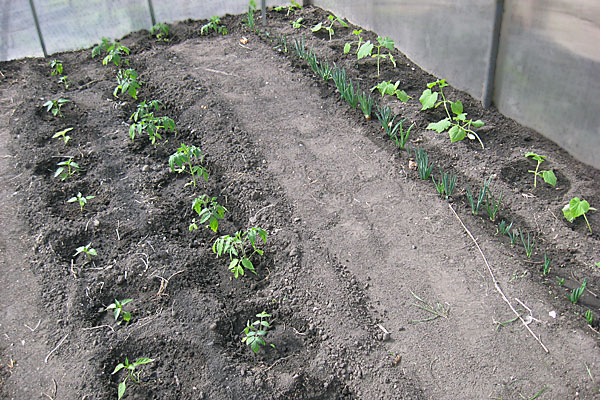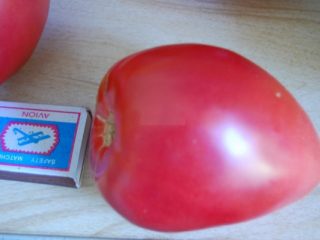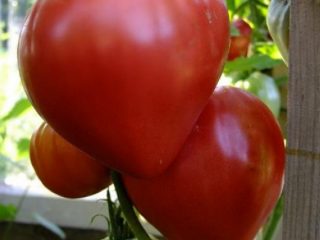Content
Tomato Swamp is a new product bred by breeders of the Moscow Agricultural Academy. Timiryazev at the beginning of the 21st century, the originator was the Gisok company. By 2004, the variety passed all the necessary tests and was included in the State Register for small farms in the European part of the country. Tomatoes of this variety got their unusual name due to the swamp-green color of ripe fruits.
Description of tomatoes Swamp
The Swamp variety is indeterminate, that is, the growth of the bush does not stop even after flowering and continues as long as weather conditions permit.
In open ground, the height of a plant of this variety rarely exceeds 110 cm, the length of the stem of the shortest specimens is about 80 cm. In a greenhouse, the plant can reach 150 cm. According to reviews and photos, the Bog tomato can grow up to 180 cm.
The stems are strong, thick, the leaves are large, of the usual shape for a tomato, somewhat loose to the touch. The flowers are small, yellow, collected in simple or intermediate (double) inflorescences. The first cluster appears above the ninth true leaf, subsequent ones are formed every three leaves.
Description of fruits
The Swamp variety is distinguished by flat-round, ribbed fruits. Tomatoes that have not reached maturity are green in color, with a darker spot visible around the stalk. When ripe, they do not change color, only sometimes a slight yellowness or a slight copper tint is added. Pink, yellow or red spots and streaks may appear on the skin. When overripe, the top often acquires a pale pink tint.
The fruits of the Boloto variety are medium to large in size, their weight is 100–250 g; in greenhouses and hotbeds this figure can reach 350 g. In cross-section, tomatoes are also green in color and have at least 4 seed chambers filled with green gel.
Tomatoes of the Boloto variety are distinguished by a pronounced sweet taste with sourness and have a pleasant fruity aroma. The pulp is loose, tender, oily, juicy. Many lovers of exotic versions of this vegetable note that its fruit is the most delicious of all green tomatoes. The pulp of this variety of tomatoes contains vitamin C and beta-carotene.
The Boloto variety was bred primarily for preparing fresh salads, side dishes and snacks, but housewives have found wide use for it in canning, as evidenced by numerous reviews with photos of Boloto tomatoes being prepared for the winter. You can pickle them either as whole fruits or as part of vegetable mixtures. Tomatoes of this variety are universal and their scope of application is limited only by their very low shelf life. For this reason, they are not used commercially or stored in their raw form.
Characteristics of tomato Swamp
Like other varieties, the Bog tomato is preferable to grow in greenhouses and hotbeds. In the southern regions of the country, the plant thrives in open ground.
The description of the Boloto tomato indicates that the variety has an average yield: when planted, no more than 3 bushes per 1 sq. m. m. in open ground, up to 5.5 kg is collected from this area, and in greenhouses – up to 6 kg.
Harvesting the fruits of this early-ripening variety can begin as early as 90–95 days after planting, that is, fruiting begins in mid-June and continues until the end of August.
Despite the fact that the Swamp variety does not require special care compared to other varieties of tomatoes, the yield greatly depends on the growing conditions and care. The following factors have the greatest positive impact on the quantity and quality of fruits of this variety:
- seed treatment before sowing: soaking in a solution of potassium permanganate and treatment with a stimulant;
- growing crops at a temperature of +22°... +25°C (in a greenhouse);
- planting on light soils with a neutral acidity level;
- maintaining optimal planting density: 40x50 cm;
- abundant regular watering with warm water, avoiding waterlogging of the soil;
- periodic feeding with mineral complexes with nitrogen, potassium and phosphorus or organic fertilizers;
- formation of a bush into two stems;
- mulching;
- preventive treatment against diseases.
The Swamp variety is not resistant to tomato diseases. The most common ailments are rot, late blight and anthracnose. The latter disease poses a serious danger to roots and fruits. Anthracnose can be noticed by the appearance on the tomato of first a soft and then a black spot, which increases in size over time.The pulp in this part of the fruit becomes watery and soon begins to rot. As with other representatives of this crop, aphids, whiteflies and other pests pose a danger to Swamp tomatoes.
You can cope with diseases by pre-sowing seed treatment with an antiseptic solution. For the prevention and treatment of adult plants, spraying of bushes with solutions of copper and sulfur, as well as with the preparations “Flint” and “Quadris” is used. To avoid a dangerous increase in humidity, the greenhouse must be ventilated after each watering.
Advantages and disadvantages
Despite the relative youth of the variety, Boloto tomatoes have already won many fans. Vegetable growers appreciated the following advantages:
- unusual exotic taste and aroma;
- original type of fruit;
- versatility of use;
- relative unpretentiousness of the variety;
- early harvest dates.
When choosing a Swamp tomato for planting, you should also take into account its disadvantages:
- low shelf life, poor transportability;
- the need to tie up and trim bushes;
- sensitivity to tomato diseases.
Rules for planting and care
Growing a Swamp tomato does not require additional effort. Experienced gardeners claim that even a beginner can cope with caring for this variety.
The first and one of the most important stages of growing is forcing seedlings. The main thing is to prepare the seeds correctly in order to get friendly, strong shoots.
Sowing seeds for seedlings
Tomatoes for seedlings are sown between February 20 and March 10. To select healthy seeds, they are poured into a salt solution (1 tablespoon of salt per 1 glass of water).Those that float are collected - they are not suitable for sowing. Those that have settled to the bottom are dried, treated with a solution of immunocytophyte or potassium permanganate and placed in a damp cloth for a day.
As with other varieties, the material can be sown in a common container, plastic cups or peat pots. Light nutrient soils are best suited for seedlings. Ready-made substrate can be purchased at the store, but you can prepare it yourself by mixing peat, sand and soil in equal proportions. To disinfect the soil, you should spill it with boiling water in advance. The seeds are buried 1 cm, moistened, covered with film and left at room temperature. Seedlings need good lighting and regular watering.
If the seeds were planted in a common container, then at the stage of 2–3 true leaves the seedlings must be picked.
Transplanting seedlings
In the Central region of Russia, seedlings are transplanted into a greenhouse or hotbed from the end of May to the beginning of June, when the plants produce 8–9 leaves and reach a height of 25 cm. Before this, many gardeners harden off the seedlings for a week, taking them out into the open air for several hours. It should be remembered that frosts are detrimental to young plants. When transplanting into open ground, they are guided by the average daily temperature, which should not be lower than +13°C. In case of cold weather, covering them with film will help to save seedlings planted in open ground.
Tomato Swamp prefers light soils with neutral acidity. The soil is dug up, organic and mineral fertilizers are applied and moistened with a weak solution of potassium permanganate for disinfection.
For transplanting, it is best to choose a cool, windless day. Plants are buried 2 cm and watered well.
The planting density, as for other varieties of tomatoes, is 40x50 cm or 50x50 cm.
Growing in open ground
Tomatoes are a moisture-loving crop, so they require regular, abundant watering with warm water. As with caring for other varieties, it is done in the evening. After watering, the soil around the plant is loosened from time to time to provide air access to the roots and get rid of weed.
The plants are fed with complex mineral fertilizers or organic matter 3-4 times per season.
To increase the yield of the Boloto variety, a bush of 2 stems is formed. The best time for this is when the young plant is sufficiently strong and begins to grow.
The shoots are planted from the first cluster with flowers when they reach a length of 5–7 cm. During the season, the shoots are planted 2–3 times.
Tall tomato bushes Swamp need staking, so already at the stage of transplanting into the ground, pegs are installed next to the seedlings and the plant is loosely tied.
Mulching, which has recently become popular, can increase productivity, accelerate fruit ripening and make it easier to care for tomatoes. This procedure involves covering the top layer of soil with natural or artificial materials that protect the soil from drying out and weed growth. Leaves, pine needles, sawdust, mown grass and other natural materials that allow air to pass through well are used as mulch.
How to grow a tomato Swamp in a greenhouse
Caring for Swamp tomatoes in a greenhouse should be done in the same way as for plants planted in open ground. You just need to keep in mind that water stagnation often occurs in greenhouses, which can lead to rot in plants. To avoid waterlogging, gardeners ventilate them after each watering.
Conclusion
Tomato Boloto is a variety about which you can find a variety of reviews. Some vegetable growers consider low keeping quality, instability to diseases and relatively low yield as significant disadvantages. However, the variety also has its fans, who appreciate the ease of care, exotic appearance and wonderful taste of the fruit.












